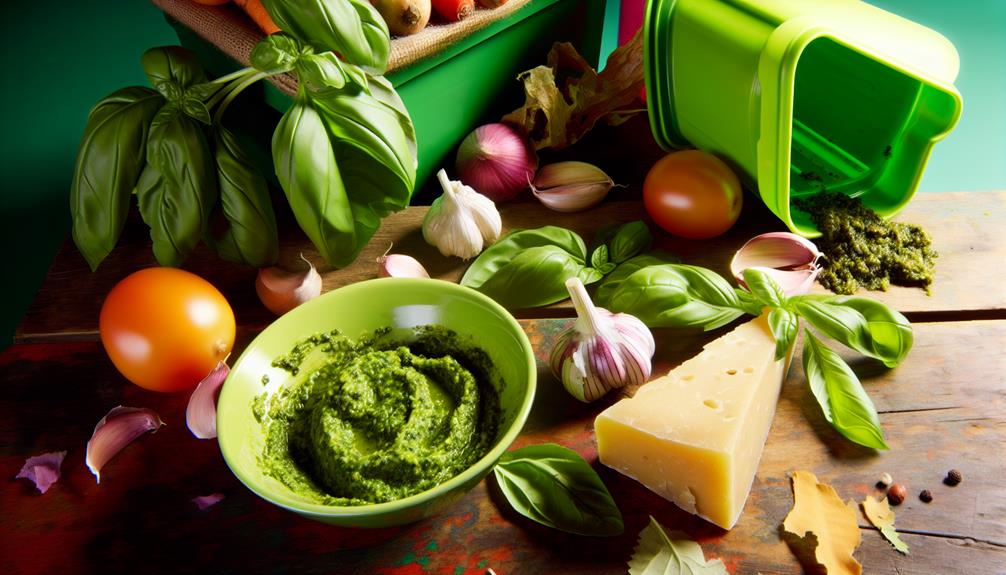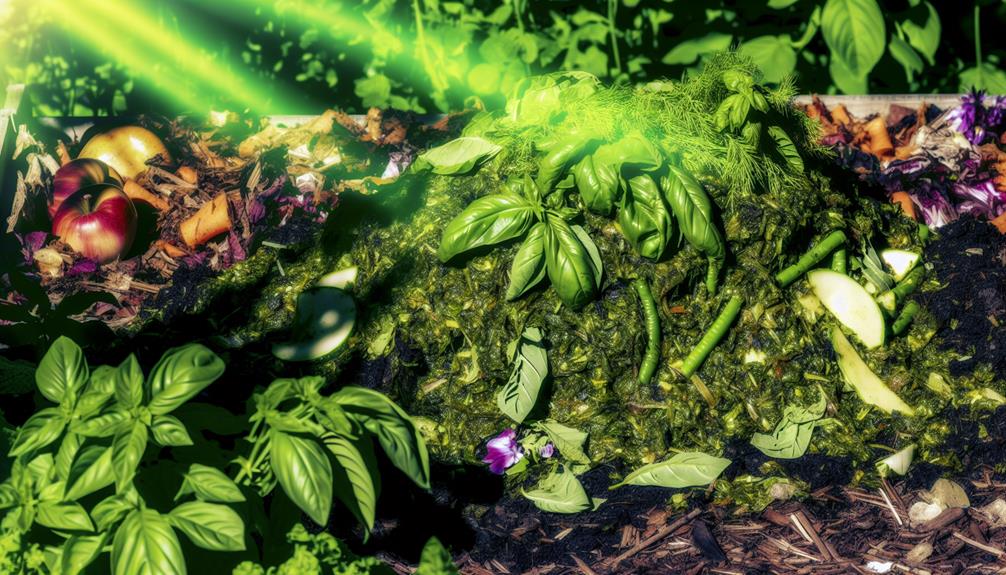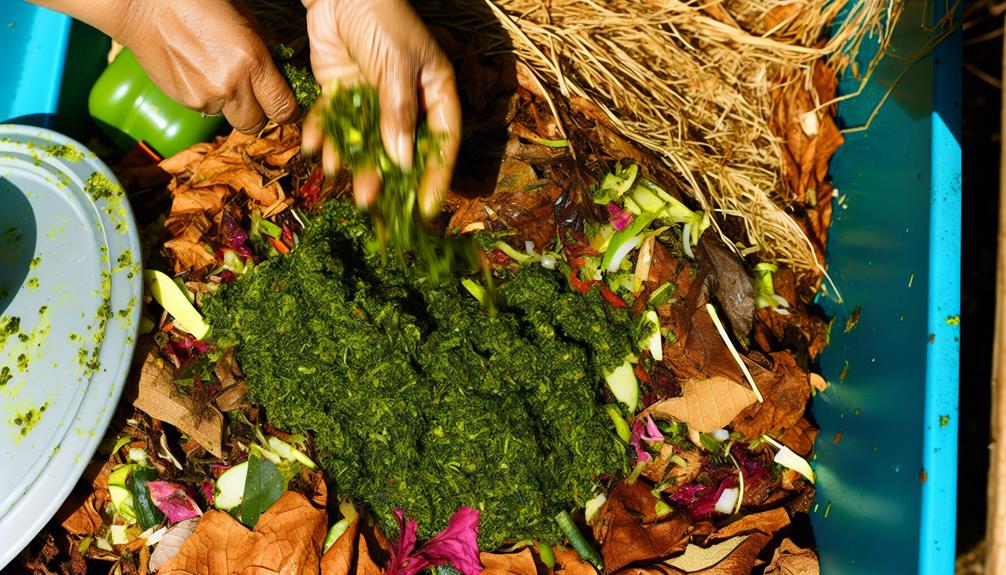

You can compost pesto, but you need to manage it correctly. Pesto’s ingredients like basil, garlic, and pine nuts enrich compost. However, oils and cheese can slow decomposition and attract pests. To compost pesto effectively, balance it with dry, carbon-rich materials like leaves or cardboard. Chop larger pieces and mix thoroughly to enhance breakdown.
Monitor moisture levels to prevent unpleasant odors and turn the compost regularly to maintain aeration. By following these steps, you can guarantee your compost thrives while incorporating pesto. There’s more detailed advice available for optimizing your compost pile with pesto.
To make the perfect pesto, you’ll need a few essential ingredients that bring out its vibrant flavors. First and foremost, fresh basil is the star of the show. If you have an herb garden, you’re in luck. Growing your own basil guarantees you have the freshest leaves, which are key to a flavorful pesto. Basil from your garden isn’t just fresher; it also enhances your connection to the food you create.
Next, let’s talk about the other components. Pine nuts add a creamy texture and subtle sweetness. When sourcing ingredients, look for high-quality nuts, as they can greatly impact the final taste. Garlic brings a sharp bite, while Parmesan cheese offers a salty, umami depth. For the best results, grate your Parmesan fresh.
Don’t forget the olive oil, which binds everything together and adds richness. Opt for extra virgin olive oil for its superior flavor. Finally, a pinch of salt ties everything together.
When sourcing these ingredients, prioritize fresh, high-quality options to elevate your pesto. By paying attention to ingredient sourcing and utilizing your herb garden, you’ll create a pesto that’s both delicious and deeply satisfying.
Composting is an excellent way to recycle kitchen scraps and yard waste into nutrient-rich soil for your garden. Start by choosing the right compost bin for your space—whether it’s a small countertop bin or a larger outdoor one, there’s an option that fits every lifestyle. Compost bins help manage waste efficiently, keeping your compost pile contained and reducing odor.
You’ll need to balance green materials like fruit and vegetable scraps, coffee grounds, and grass clippings with brown materials such as leaves, cardboard, and newspaper. This balance is essential for maintaining the proper decomposition process. Using compostable bags can make it easier to collect and transport your kitchen scraps without creating messes.
Turn your compost regularly to aerate the pile, which speeds up the decomposition process. Water your compost lightly if it becomes too dry, but avoid overwatering. The goal is to maintain a consistency similar to a damp sponge.
Remember to keep meat, dairy, and oily foods out of your compost bin, as they can attract pests and create unpleasant odors. By following these simple steps, you’ll be well on your way to creating a thriving compost pile that benefits both your garden and the environment.
Also Read: Can You Compost Cat Food?
When you add pesto to your compost pile, you need to understand how its ingredients break down.

The composting process will be impacted by the oils and herbs in the pesto, which can enrich your compost with valuable nutrients.
Properly managed, composting pesto can offer potential benefits for your garden soil.
Imagine the aroma of fresh basil, garlic, and pine nuts wafting through your kitchen as you prepare a batch of homemade pesto, and consider how each ingredient might contribute to your compost pile.
When thinking about ingredient sourcing, you might use organic basil, garlic, and pine nuts, which are great for composting due to their natural, biodegradable properties. Each component breaks down differently, adding unique benefits to your pile.
Here’s a breakdown of common pesto ingredients and what they offer:
When considering flavor variations like substituting nuts or adding cheese, remember these can affect your compost. Cheese, for instance, might attract pests, so use it sparingly.
Consider how the ingredients in your pesto can influence the decomposition rate and overall health of your compost pile. Pesto typically contains oil, nuts, and sometimes cheese, which can impact microbial activity and decomposition rates. While these ingredients are organic, they break down at different speeds, with oil and cheese decomposing slower than leafy basil or garlic.
To maintain a healthy compost pile, balance is crucial. You should mix your pesto with a variety of other compostable materials. This helps guarantee that microbial activity stays robust, aiding in the breakdown of all components effectively. Too much oil or cheese can create anaerobic conditions, which slow decomposition and may produce unpleasant odors.
To optimize decomposition rates, chop larger pesto components into smaller pieces before adding them to your compost. This increases the surface area for microbes to work on, speeding up the process.
Also, consider layering your pesto with green and brown materials, such as grass clippings and dried leaves. This balance supports the microbial community, ensuring your compost pile remains healthy and active.
Incorporating pesto into your compost pile can enrich the soil with essential nutrients, enhancing the overall health of your garden. Pesto, made from ingredients like basil, garlic, olive oil, and pine nuts, breaks down to release valuable nutrients that benefit your compost.
Here’s how adding pesto can improve your compost pile:
Understanding the balance between green and brown materials is essential for creating effective compost. Green materials, rich in nitrogen, and brown materials, rich in carbon, need to be properly balanced to guarantee a healthy composting process. Nitrogen-rich greens include kitchen scraps, like vegetable peels and coffee grounds, while carbon-rich browns include items like dried leaves and cardboard.
To help you differentiate and balance your compost ingredients, here’s a handy table:
| Green Materials | Brown Materials | Notes |
|---|---|---|
| Vegetable Peels | Dried Leaves | Greens add nitrogen |
| Coffee Grounds | Cardboard | Browns add carbon |
| Grass Clippings | Shredded Paper | Balance is key |
| Fruit Scraps | Straw | Too much green can smell |
| Fresh Manure | Wood Chips | Too much brown slows down |
Achieving the right nitrogen balance is important. If your compost pile smells bad, you probably have too many greens. Conversely, if it decomposes too slowly, you might have too many browns. Aim for a ratio of roughly 2:1 browns to greens. This balance helps maintain the right carbon sources for microbes to thrive and break down the materials efficiently.
Also Read: Can You Compost Butter?
Balancing your compost materials is important, but managing oil in compost poses its own unique challenges. Oils, like those found in pesto, can slow down the decomposition process and create unpleasant odors if not properly addressed. To guarantee your compost thrives, you need to take extra steps for effective oil absorption and proper composting of oils.
Here are three practical tips to help you manage oil in your compost:
When composting pesto, make sure to break down any nuts and seeds to expedite their decomposition. Nuts and seeds can take a long time to break down naturally, which could slow the composting process. By crushing or grinding them before adding to your compost pile, you’re guaranteeing they decompose more efficiently. This not only accelerates seed decomposition but also enhances nutrient absorption, providing richer compost for your garden.
You might wonder why this step is important. Well, whole nuts and seeds have tough outer shells that can resist breaking down. By pre-processing them, you’re exposing more surface area to microbes, which speeds up their work. Plus, when nuts and seeds decompose faster, they release their nutrients more readily. This means your compost will be richer in essential elements that plants crave.
To crush nuts and seeds, you can use a food processor or even a mortar and pestle. Once ground, mix them thoroughly into your compost. This ensures an even distribution and prevents clumping. Remember, the key to effective composting is creating an environment where all materials can break down efficiently, contributing to a balanced, nutrient-rich compost.
Also Read: Can You Compost Yogurt?
When composting pesto, it’s important to manage the oil content to prevent your pile from becoming too wet.

Incorporate dry materials like leaves or cardboard to balance the moisture levels.
Regularly monitor your compost’s moisture to guarantee it remains damp but not soggy.
Managing pesto’s oil content is essential to maintaining the right moisture levels for composting. Too much oil can disrupt the balance of your compost pile, leading to slower decomposition and potential odor issues.
Here are some effective steps to manage oil content:
To balance moisture levels in your compost, incorporate dry materials like straw, wood chips, or shredded paper. These materials, known as carbon sources, help absorb excess moisture and provide the necessary balance for best decomposition.
When you add pesto, which tends to be oily and moist, it’s important to offset this with dry, carbon-rich materials. First, gather your dry materials. Straw and wood chips are great options, but shredded paper works well too. Aim for a mix of these to make sure a balanced compost pile.
Layer these carbon sources with your food scraps and pesto to create a well-aerated environment. Turning compost regularly is another key step. When you mix your pile, you distribute moisture evenly and introduce oxygen, which speeds up the decomposition process.
Aim to turn your compost every few weeks, especially after adding new materials.
Keep an eye on your compost’s moisture by regularly checking its consistency; it should feel like a wrung-out sponge. This balance is essential for effective composting.
Here’s how to maintain it:
Effective composting practices guarantee that your pesto pile stays odor-free and pest-resistant. Start with pest control by ensuring your compost bin is secure. A lid or fine mesh cover will help keep out rodents and insects. Regularly turning your compost aerates it, which not only speeds up decomposition but also deters pests that prefer undisturbed food sources.
For odor prevention, balance is key. Pesto contains oils and dairy, which can produce strong smells if not managed well. Mix your pesto with plenty of dry, carbon-rich materials like leaves, straw, or shredded newspaper. This balance of greens (nitrogen-rich materials like pesto) and browns (carbon-rich materials) helps maintain a neutral odor. Avoid adding large quantities of pesto all at once—spread it out over time.
Additionally, monitor moisture levels. Too much water can create anaerobic conditions, leading to unpleasant odors. Aim for a compost consistency similar to a damp sponge. If it’s too wet, add more dry materials; if it’s too dry, add water gradually.
If composting pesto isn’t feasible, there are several other eco-friendly disposal methods you can consider. By exploring these alternatives, you can still make a positive environmental impact while making sure your pesto doesn’t go to waste.
These methods help you dispose of pesto responsibly while contributing to your community and environment.
When contemplating composting store-bought pesto, consider ingredient contamination and packaging disposal. You’ll need to verify no harmful ingredients and properly dispose of or recycle the packaging to maintain a healthy compost environment.
Temperature fluctuations can greatly impact how well you compost pesto. Consistent warmth boosts microbial activity, speeding up decomposition. However, if temperatures drop too low, microbes slow down, prolonging the composting process. Stay involved and monitor your pile!
When you compost pesto, you’re contributing to nutrient recycling and soil enrichment. It’s a great way to reduce waste and support a healthier environment. By composting, you’re helping your community thrive through sustainable practices.
You can compost pesto made with vegan ingredients. Vegan oils and fresh herbs break down easily, enriching your compost. By composting, you contribute to a sustainable community and share in eco-friendly practices with like-minded individuals.
You’re probably curious about the decomposition rate of pesto in a compost pile. Typically, it takes a few months for pesto to undergo organic breakdown, depending on factors like temperature and the balance of compost materials.
To compost pesto effectively, balance green and brown materials, manage oil content, and be cautious with nuts and seeds.
Guarantee your compost pile maintains proper moisture levels to avoid pests and odors.
If composting pesto seems too complicated, consider alternative disposal methods like using it in cooking or distributing it in smaller amounts to avoid overwhelming your compost.
With these tips, you can successfully integrate pesto into your composting routine.
